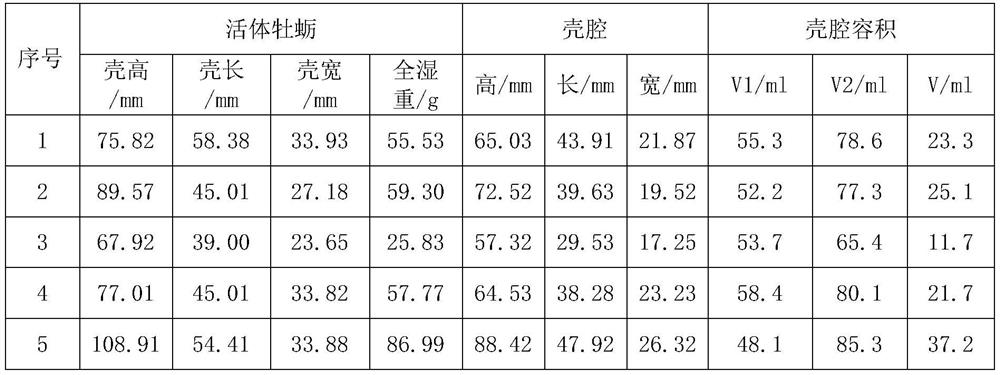A method for obtaining shellfish shell cavity and measuring its volume
A shellfish and volume technology, applied in the field of aquatic biology, can solve problems such as increasing measurement errors, and achieve the effects of being easy to use, easy to obtain, and simple to operate.
- Summary
- Abstract
- Description
- Claims
- Application Information
AI Technical Summary
Problems solved by technology
Method used
Image
Examples
Embodiment 1
[0035] (1) Prepare a 100ml measuring cylinder, distilled water, and 5 oysters to be tested (the average shell height, shell length, shell width, and wet weight are: 83.85±16.01mm, 48.36±7.86mm, 30.49±4.80mm, 57.08±21.67 g), fire retardant mud 2kg.
[0036] (2) Fill fire retardant mud into the oyster shell cavity where the soft body is removed. The amount of fire retardant mud slightly exceeds the volume of the shell cavity. After filling, close the left and right shells and squeeze hard to remove the fire retardant outside the extruded shell. mud.
[0037] (3) Take out the fire retardant putty in the shell cavity in step (2), the shape of the fire retardant putty is the shape of the shell cavity, and measure its height, length and width.
[0038] (4) Fill a certain amount of distilled water into a 100ml measuring cylinder, and record the volume V1;
[0039] (5) Knead the fire-retardant mud in the shell cavity of step (3) into a strip shape, and place it in the measuring cyli...
Embodiment 2
[0045] (1) Prepare a 100ml measuring cylinder, distilled water, and 5 oysters to be tested (average shell height, shell length, shell width, and wet weight are: 82.24±21.18mm, 52.18±25.67mm, 26.26±6.32mm, 50.50±18.91 g).
[0046](2) Put an appropriate amount of distilled water in a square tank of 40cm×20cm×10cm, submerge the oyster that has taken out the soft body into the distilled water, fill the inner cavity of the oyster with the finishing water, and tie the two shells with rubber bands to make the two shells completely closed state. Place the square tank in a -20°C refrigerator until the distilled water is completely solidified.
[0047] (3) Take out the ice around the oysters in the square tank in step (2), and take out the oysters one by one. Take out the ice in the shell cavity, the shape of the ice is the shape of the shell cavity, and quickly measure its height, length, and width.
[0048] (4) Place the ice in the shell cavity measured in step (3) in a 100ml measu...
PUM
 Login to View More
Login to View More Abstract
Description
Claims
Application Information
 Login to View More
Login to View More - R&D
- Intellectual Property
- Life Sciences
- Materials
- Tech Scout
- Unparalleled Data Quality
- Higher Quality Content
- 60% Fewer Hallucinations
Browse by: Latest US Patents, China's latest patents, Technical Efficacy Thesaurus, Application Domain, Technology Topic, Popular Technical Reports.
© 2025 PatSnap. All rights reserved.Legal|Privacy policy|Modern Slavery Act Transparency Statement|Sitemap|About US| Contact US: help@patsnap.com



